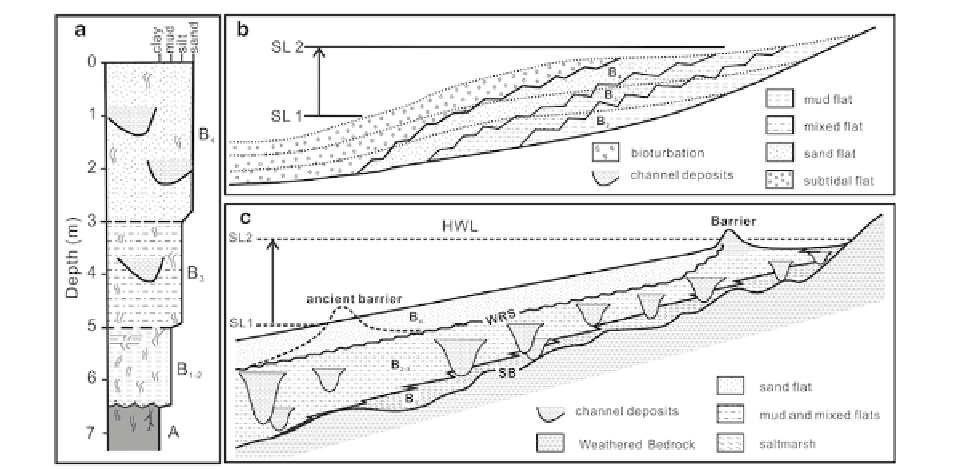Geology Reference
In-Depth Information
Fig. 9.33
(
a
) Schematic drawing of a retrogradational coarsen-
ing-upward tidal-flat succession, and (
b
,
c
) cross-shore profiles
of vertical stacked tidal-flat sub-facies in response to sea-level
rise on an open-coast setting with limited sediment input (After
Kim et al.
1999
; Yang et al.
2006b
)
highly sheltered settings (Fan
2001
; Hori et al.
2001
;
Dalrymple et al.
2003
). In the Fly Delta, the recent ver-
tical succession of tidal bar facies was found at a few
core sections to exhibit cyclic changes in lithology.
Each single cycle contains a lower half coarsening-
upward succession and an upper half fining-upward
succession, counting 26 sand laminae which are close to
28 tides for a semidiurnal tidal setting (Fig.
7
a in
Dalrymple et al.
2003
). These features, together with the
thick-thin alternation of adjacent sand laminae for the
spring tidal deposits, have been undoubtedly interpreted
to be the tide-generated neap-spring cycles and the
diurnal inequality, respectively (Dalrymple et al.
2003
).
Sand-mud couplets with cyclical changes in lamina
thickness are common features in the early Holocene
estuarine facies of the Changjiang Delta (Fan
2001
;
Hori et al.
2001
). The core section of 47.12-48.49-m
depth in the borehole CM-97 contains four complete
neap-spring cycles (Fig.
9.34
). The cycles are more
clearly shown by variations in sand-laminae thickness
(not including the very thin sand laminae within the
mud couplets) through using 5-point adjacent averag-
ing smoothing method. Discrete Fourier analysis of
the smoothed data shows an average peak period at
28.4 laminae (25.2-31.5), matching well with 28 semi-
diurnal tides within a neap-spring cycle. Mud couplets
and the superposition of current ripples with opposite
foreset dipping directions are other good indicators of
tidal origin. It is therefore hypothesized that the
estuarine and deltaic-distributary channels potentially
accommodate some rapid filling successions contain-
ing the neap-spring cycles.
9.7.2
Ancient Examples
Ancient tidalites have been extensively studied in the
last three decades, typically those registering tidal cycle
signals. Due to an excessive passion for periodic cycles,
the dramatic growing publications are biased toward
the cyclic tidal rhythmites with the neap-spring cycles.
Noncyclic rhythmites have been greatly neglected even
though they may contain the seasonal wave-climate
cycles. Only a few ancient tidal rhythmites have been
undoubtedly interpreted as the open-coast tidal-flat
environments (Klein
1970
; Fan et al.
2004b
).
9.7.2.1 Tonglu (Late Ordovician)
Tonglu tidalites of the Late Ordovician age are well
outcropped along a roadcut near Tonglu County,
Zhejiang Province, east-central China (Fan et al.
2004b
). They are the uppermost member subdivision

